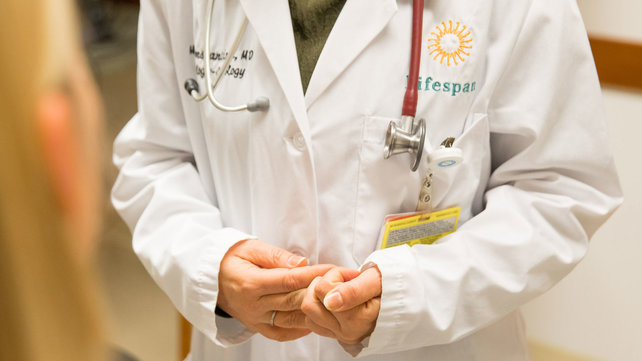Chest Pain in Children and Teens: Should You Be Concerned?

It is common for children and teenagers to occasionally feel sharp chest pains. These pains are typically brief, but at times they can be quite intense and scary. For this reason, and because chest pain is a well-recognized symptom of serious heart disease in older adults, children and teens with these pains are often referred to a pediatric cardiologist for evaluation. Fortunately, most chest pains in children and teens are benign and not related to any abnormality of the cardiovascular system.
What are the most common causes of chest pain in children and teens?
Most chest pain in children and teens is benign and related to the chest wall, rather than due to any problem with the heart. This can be true even when a child or teen says that “my heart hurts.” Costochondritis and precordial catch syndrome are the most common causes of such benign chest wall type pains.
Costochondritis
This is a type of joint pain, located in the costochondral joints. These joints are where the ribs and the costal cartilages of the sternum connect. The pain is typically sharp or stabbing, spanning two or three of these joints and often only along one side of the chest. These pains can last anywhere from seconds to a few minutes and deep breaths in will make the pain worse. The pain most often occurs only while sedentary, such as while lying on the couch watching TV. There will be no evidence of any inflammation (warmth, redness, swelling) around these costochondral joints. Pressing on the specific area over the chest where the pain occurred will typically reproduce the pain. Reproducing pain by firmly pressing over the affected area is an important part of the physical exam performed by medical providers when diagnosing costochondritis.
Precordial Catch Syndrome
This type of chest pain is sharp and classically localized to one intercostal space along the lower side of the sternum or breastbone. This type of pain is almost exclusively present along the left side of the chest and lasts only a few seconds in duration. It typically occurs while sedentary but can be present with activities that involve mild exertion. It is most often seen in the teenage years (although this pain can be present in children) and is worse when breathing in. Some who suffer from this pain report that shallow breathing helps to alleviate their symptoms while others report that a forced deep breath will result in a “bubble popping” sensation in the chest and resolution of the pain. It is speculated that the pain results from a “pinched nerve” and spasming of the intercostal muscle fibers.
Other common causes of benign chest pain
Chest wall trauma is also a known cause of chest pain, particularly in those who participate in sports or activities that are prone to such trauma. Weightlifting is a common cause of muscle strain to and around the chest wall in teenagers. Localized tenderness and pain at the site of injury, sometimes with redness/swelling, is often noted. Scoliosis or other chest wall deformities may be associated with nerve compression or significant musculoskeletal strain, resulting in chest pain.
The cause of chest pain can sometimes be traced to the gastrointestinal system. These pains are typically reported to be “burning,” located around the epigastric area (between the sternum and the belly button) and often are related to eating. Common causes of these type of pains include acid reflux or GERD and esophageal spasm or inflammation. Less common culprits include esophageal strictures or ingestion of foreign bodies. A patient with a history of asthma may be experiencing chest pain as the result of an airway spasm.
Older children and teenagers can sometimes experience chest pain which is the result of a recent life stressor or from an underlying anxiety or panic disorder. The chest pain may, at least in part, be related to tension in the chest wall and pectoral muscles and/or due to a surge in “stress hormones.” Pains like these have been described as sharp or stabbing but also as dull with a heaviness of the chest. These types of pains are often associated with other complaints, such as abdominal pain, a racing heart rate and difficulty sleeping. It can often be difficult to discern if a patient’s anxiety is the result of chest pain or vice versa.
What to do for benign chest pain
Any child or teen who reports a history of chest pain should be evaluated by their pediatrician. A detailed history and physical exam are the key to determine if chest pain is benign or if additional work up of the pain might be warranted. When historical features and exam findings suggest a benign chest wall-related cause, such as costochondritis, precordial catch syndrome, or injury, treatment should focus on pain relief with NSAIDs (ibuprofen, naproxen) and rest. Routine chest wall stretches can be helpful in reducing recurrence of these pains. Reassurance and education that these types of chest pains are benign and not life threatening is a very important component of treatment, particularly in children and teens who might suffer from anxiety. Treating gastrointestinal, airway or traumatic origins of chest pain should be focused on these underlying problems.
When should I be concerned that chest pain in my child or teen might not be benign?
If your child or teen experiences any of the following, your pediatrician may consider referring your child or teen to a pediatric cardiac specialist, such as those at the Hasbro Children's Pediatric Heart Center, for a consultation:
- Chest pain that occurs with exertion
- Chest pain that is associated with palpitations, dizziness or syncope (passing out)
- Chest pain with history of cardiac surgery or other cardiac interventions
- Chest pain with history of Kawasaki disease
- Chest pain with family history of sudden cardiac death
- Chest pain with personal or family history of an arrhythmia or genetic disorder
- Chest pain with personal history of elevated cholesterol
- Chest pain with family history of elevated cholesterol in a sibling or parent
- Chest pain with abnormal cardiac physical exam findings
You should seek immediate medical attention or call 911 should your child or teenager experience chest pain that is associated with dizziness, syncope (passing out), palpitations, a racing heartbeat, or pain that radiates to the neck, jaw, arm, or back.
For more information on children’s health, visit the Grow section of our Be Well blog.
About the Author:
Thomas J. Seery, MD
Dr. Thomas Seery is the medical director of the Pediatric Heart Center at Hasbro Children's and an associate professor of pediatrics at The Warren Alpert Medical School of Brown University.
Find a Doctor

The right provider is in our network
Search more than 1,200 providers in our network.



